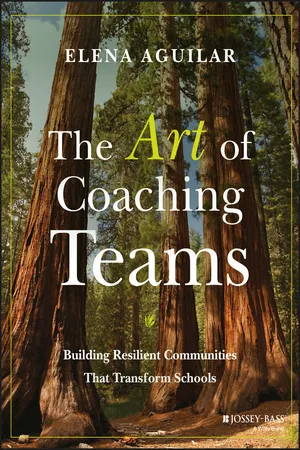
The Art of Coaching Teams
Building Resilient Communities that Transform Schools
- English
- ePUB (mobile friendly)
- Available on iOS & Android
About this book
The missing how-to manual for being an effective team leader
The Art of Coaching Teams is the manual you never received when you signed on to lead a team. Being a great teacher is one thing, but leading a team, or team development, is an entirely different dynamic. Your successes are public, but so are your failures—and there's no specific rubric or curriculum to give you direction. Team development is an art form, and this book is your how-to guide to doing it effectively. You'll learn the administrative tasks that keep your team on track, and you'll gain access to a wealth of downloadable tools that simplify the "getting organized" process. Just as importantly, you'll explore what it means to be the kind of leader that can bring people together to accomplish difficult tasks. You'll find practical suggestions, tools, and clear instructions for the logistics of team development as well as for building trust, developing healthy communication, and managing conflict.
Inside these pages you'll find concrete guidance on:
- Designing agendas, making decisions, establishing effective protocols, and more
- Boosting your resilience, understanding and managing your emotions, and meeting your goals
- Cultivating your team's emotional intelligence and dealing with cynicism
- Utilizing practical tools to create a customized framework for developing highly effective teams
There is no universal formula for building a great team, because every team is different. Different skills, abilities, personalities, and goals make a one-size-fits-all approach ineffective at best. Instead, The Art of Coaching Teams provides a practical framework to help you develop your group as a whole, and keep the team moving toward their common goals.
Frequently asked questions
- Essential is ideal for learners and professionals who enjoy exploring a wide range of subjects. Access the Essential Library with 800,000+ trusted titles and best-sellers across business, personal growth, and the humanities. Includes unlimited reading time and Standard Read Aloud voice.
- Complete: Perfect for advanced learners and researchers needing full, unrestricted access. Unlock 1.4M+ books across hundreds of subjects, including academic and specialized titles. The Complete Plan also includes advanced features like Premium Read Aloud and Research Assistant.
Please note we cannot support devices running on iOS 13 and Android 7 or earlier. Learn more about using the app.
Information
Chapter 1
Refining a Vision
Humanities Team, 2008
A Note on Terms
What is a Great Team?
Exhibit 1.1: Dimensions of a Great Team: A Tool for Reflection
| Dimension | Indicators | Yes/No |
| Product Something of quality gets done that is valuable, useful, and appreciated. | Was our product well received? | |
| Did our clients (students, teachers, parents, staff) think that our product was high quality? | ||
| Did what we do make a difference to our clients? | ||
| Do I feel proud of the work we did together? | ||
| Process The group's collaboration skills increase as a result of working together. | Did our ways of working together improve over time? | |
| Did our ability to communicate with each other, manage unproductive conflict, and have healthy conflict increase? | ||
| If I was to continue working with this team, do I feel confident that our work products would continue to improve because we've figured out how to best work together? | ||
| If the team has disbanded: If this team were to reconvene, would I want to rejoin it? | ||
| Learning The team experience is a learning experience that increases the skills and knowledge of individual team members. | Did I learn in this team? | |
| Did being a part of this team help me improve my skills in my primary area of practice (e.g., teaching, coaching, leading)? | ||
| Did I feel I could take risks in my learning in this team? | ||
| Did I trust the other people in this team most of the time? | ||
| Did I feel like I belonged to a community? |
1. Product: A great team gets something done that is valuable, useful, and appreciated
2. Pro...
Table of contents
- Cover
- Praise Page
- Title Page
- Copyright
- Table of Contents
- Dedication
- Exhibits
- Introduction
- A Note on Anonymity and Pseudonyms
- Chapter 1: Refining a Vision
- Chapter 2: Knowing Ourselves as Leaders
- Chapter 3: Creating a Culture of Trust
- Chapter 4: Defining Purpose, Process, and Product
- Chapter 5: Laying a Foundation for Trust
- Chapter 6: Developing the Emotional Intelligence of a Team
- Chapter 7: Cultivating Healthy Communication
- Chapter 8: Making Good Decisions
- Chapter 9: Supporting Adult Learners
- Chapter 10: Orchestrating Meaningful Meetings
- Chapter 11: Setting the Stage for Artful Meetings
- Chapter 12: Navigating Conflict
- Chapter 13: Assessing Organizational Conditions
- Conclusion: Coming to an End
- Appendices
- Acknowledgments
- About the Author
- References
- Index
- End User License Agreement